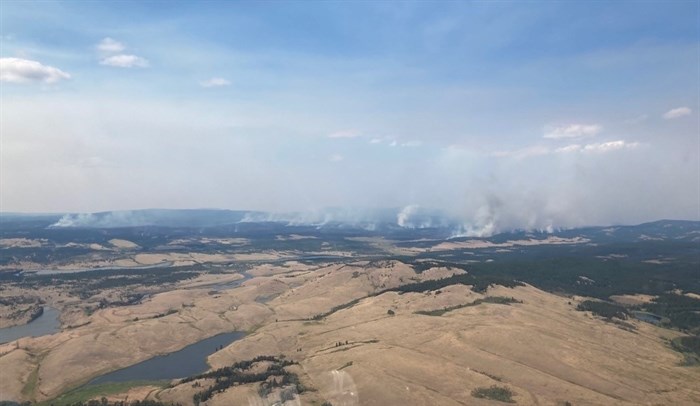
An aerial photo of the White Rock Lake wildfire on July 22, 2021.
Image Credit: B.C. Wildfire Service
September 13, 2021 - 6:00 AM
This past wildfire season was the worst on record for the Kamloops Fire Centre with nearly 500,000 hectares burned.
This year saw the greatest number of hectares burned, with the second-largest being 2017 with 109,320 hectares and third being in 2018 with 51,559 ha burned, said B.C. Wildfire Service fire information officer Taylor MacDonald.
A total of 442 fires burned 496,983 ha burned in the Kamloops Fire Centre as of Sept. 10. The Kamloops Fire Centre stretches from Lytton and Lillooet, to the Shuswap and to the South Okanagan.
The largest wildfire, the Sparks Lake fire north of Kamloops Lake, reached more than 90,000 ha in size.
The White Rock Lake wildfire, which threatened Central and North Okanagan communities, also reached more than 80,000 ha.
In 2017, the fire centre only had 243 fires, MacDonald said.
The forest fuels were incredibly dry and the Interior, along with the other areas in the province, experienced a number of hot spells. Multiple temperature records were broken in June and early July.
The record-breaking temperatures created incredibly dry conditions early in the year, she said.
READ MORE: 'Skull-crushing ridge' to bring abnormal heat to the Okanagan, Kamloops
This year, B.C. had fewer resources available than they would in a typical year with wildfires burning across the province, Alberta, the Prairies and Ontario.
“Our resourcing was a really huge challenge this year. We were able to get the out-of-country support with Mexico and Australia but just due to the pandemic and everyone vying for resources we still didn’t receive as much as we did in 2017 and 2018,” said fire information officer Taylor Colman.
This year, 98 firefighters from Mexico assisted in fighting wildfires in Okanagan, including the Nk'Mip wildfire that sparked in July near Osoyoos. The Canadian Armed Forces also assisted with fighting wildfires in the Interior this year.
Each fire centre has had different years with the greatest number of hectares burned but the drought in the Interior was “huge,” Colman said. The the northern half of the province received some rain earlier than in the season, before the Interior.
"The heatwave and then the repeated heatwaves after that was super challenging and to not have any rain at all was not great for anyone,” she said.
The last three of five years have seen significant fire seasons and we’ll see if the trend continues, Colman said. A predictor is the amount of spring precipitation.
The province also saw an influx of lightning strikes this year.
There were 1,586 wildfires with 60% caused by lightning. In 2018, there were 2061 wildfires with 1,407 were lightning-caused.
“This year was very extreme so hopefully next year things are a bit more normal so we don’t have the strain on our team,” Colman said.
To contact a reporter for this story, email Carli Berry or call 250-864-7494 or email the editor. You can also submit photos, videos or news tips to the newsroom and be entered to win a monthly prize draw.
We welcome your comments and opinions on our stories but play nice. We won't censor or delete comments unless they contain off-topic statements or links, unnecessary vulgarity, false facts, spam or obviously fake profiles. If you have any concerns about what you see in comments, email the editor in the link above.
News from © iNFOnews, 2021